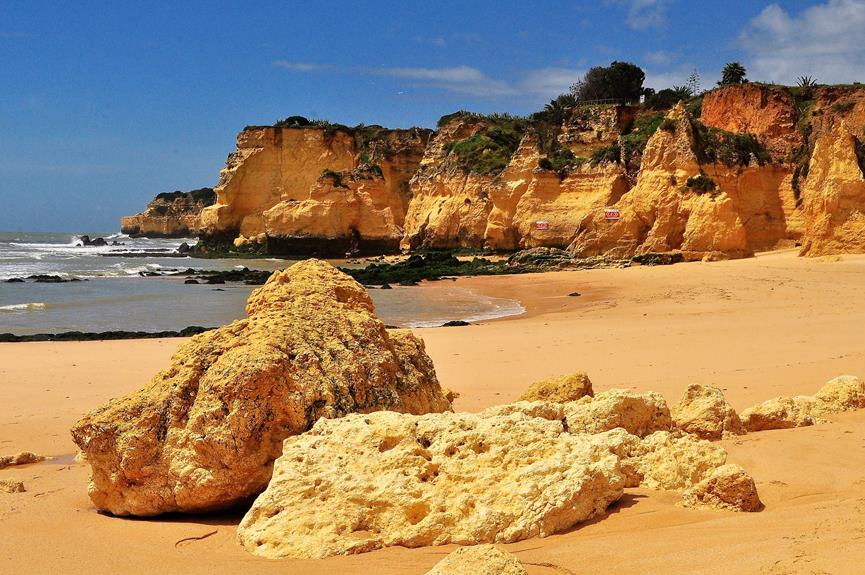Have you ever wondered why the cliff formations in the Algarve are so enigmatic? Well, let me tell you, there is a fascinating theory behind it all.
These majestic cliffs, like the ones at Ponta da Piedade, are made of golden limestone and rise proudly above the Atlantic Ocean. They boast an array of natural wonders, from caves and sea arches to towering structures and hidden grottos. Each one possesses its own unique shape and character, captivating both locals and visitors alike. In fact, local fishermen have even given names to some of these rocks, like 'Cabeça do camelo' (camel head) and 'O elefante' (the elephant).
Exploring these formations up close through boat or kayak tours is an absolute must-do activity.
So, what makes them so enigmatic? Let's dive deeper into the unique geological features, formation process, erosion and weathering effects, ecological importance, and cultural significance that contribute to their mystery.
Key Takeaways
- Algarve's cliff formations are shaped by millions of years of erosion caused by Atlantic waves.
- The continuous erosion and shaping of rock by the powerful forces of the ocean contribute to the unique geological features.
- The extensive erosion and weathering effects over millions of years have intricately sculpted the limestone coastline of the Algarve region.
- The cliffs not only have ecological importance by providing habitats for diverse marine species but also hold cultural significance, reflected in the names given by local fishermen and the historical and cultural importance of the region.
Unique Geological Features
As a geologist, I'm fascinated by the Algarve Coast's unique geological features. The Algarve region in Portugal is renowned for its extraordinary cliffs and rock formations, particularly along the southern coastline.
One prominent example is Ponta da Piedade, where towering limestone cliffs rise from the turquoise waters, creating a breathtaking sight. These cliffs have been shaped over millions of years by the relentless force of the Atlantic waves and erosion, resulting in their distinctive shapes and skylights.
Another notable formation is the Benagil Cave, a magnificent cave that formed approximately 20 million years ago. Accessible only by boat tour, it offers a unique glimpse into the geological wonders of the Algarve Coast.
Dona Ana is another captivating site, with its intricate rock formations and stunning views.
The Algarve Coast's geological features are a testament to the power and beauty of nature, making them a must-see for any visitor.
Formation Process
To understand the enigmatic nature of Algarve's cliff formations, it's necessary to delve into their intricate formation process. These formations, found in the Southern region of Portugal, have been shaped by millions of years of erosion caused by the relentless Atlantic waves.
The stunning views of the region's cliffs can be attributed to the continuous erosion and shaping of the rock by the powerful forces of the ocean. The National Park of Ponta de Piedade, known for its unique geological features, showcases the result of this ongoing process.
The limestone cliffs in this area have been sculpted into remarkable caves, natural sea arches, and towering formations. The formation process of Algarve's cliff formations is a testament to the remarkable power and beauty of nature's forces.
Erosion and Weathering Effects
One key factor in the enigmatic nature of Algarve's cliff formations is the extensive erosion and weathering effects that have shaped them over millions of years.
Located on the southern coast of Portugal, the Algarve area boasts a stunning limestone coastline that has been intricately sculpted by the erosive forces of the Atlantic Ocean.
These cliffs and sea stacks offer breathtaking coastal views, with hidden grottos and natural arches adding to the allure.
The relentless pounding of the waves, combined with the gradual wearing down of the rock by rainfall, has resulted in the creation of these unique formations.
As a result, visitors are treated to the sight of stunning rock structures that seem to defy logic, captivating the imagination and leaving one in awe of the power of erosion and weathering.
Ecological Importance
The ecological significance of Algarve's cliff formations is evident in their role as habitats for diverse marine species and their contribution to the region's overall biodiversity. These cliffs provide shelter and nesting sites for numerous seabirds, including gulls, cormorants, and shearwaters. The nutrient-rich waters surrounding the cliffs support a variety of marine life, such as fish, crustaceans, and mollusks. Additionally, the unique geological features of the cliffs create microhabitats that foster the growth of rare and specialized plant species. The pristine turquoise waters that lap against the cliffs are home to a rich array of marine flora and fauna, including seagrasses, corals, and sponges. Furthermore, the cliffs play a crucial role in protecting the coastal ecosystem from erosion and provide a natural barrier against storm surges. Overall, the ecological importance of Algarve's cliff formations can't be overstated, as they support a thriving and diverse ecosystem.
As we delve into the cultural significance of Algarve's cliff formations, it's important to recognize the deep connection between the local community and these natural wonders.
Cultural Significance
As an avid explorer of the Algarve Coast, I have been captivated by the rich cultural significance that surrounds the cliff formations. The Algarve region in southern Portugal boasts a stunning coastline that is home to magnificent cliffs and rock formations. These enigmatic formations have not only captured the imagination of locals but also hold great cultural significance. Local fishermen have given names to the rocks at Ponta da Piedade, such as 'Cabeça do camelo' (camel head) and 'O elefante' (the elephant), reflecting the folklore and tales associated with the area's geological wonders. Moreover, the Algarve was once known as Gharb Al-Andalus by the Moors, highlighting the historical and cultural importance of the region. The cliffs and formations along the Algarve's southern coastline, particularly at Praia da Piety Point (Ponta da Piedade), have become iconic symbols of the region's cultural heritage, attracting tourists from around the world.
| Cliffs and Formations | Cultural Significance |
|---|---|
| Magnificent and enigmatic | Capture the imagination |
| Named by local fishermen | Reflect folklore and tales |
| Historical and cultural importance | Gharb Al-Andalus (The West of Al-Andalus) |
| Iconic symbols of the region | Attract tourists from around the world |
Frequently Asked Questions
What Are the Cliffs in Algarve Made Of?
The cliffs in Algarve are made of limestone, a sedimentary rock. They have been shaped by erosion processes over millions of years, resulting in unique geological features and stunning coastal landscapes.
Which Rock Formations Are One of the Finest Natural Features of the Algarve?
The Ponta da Piedade rock formations are one of the finest natural features of the Algarve. With their coastal erosion, geological wonders, and dramatic landscapes, they showcase the unique formations and natural beauty of this region.
What Are the Rock Formations in Lagos Portugal?
The rock formations in Lagos, Portugal are a result of geological processes and erosion over time. These unique formations contribute to the stunning coastal landscapes and are popular tourist attractions.
Which Beach in Portugal Has Rock Formations?
Praia do Camilo in Portugal has unique coastal landscapes with impressive rock formations. Erosion and weathering processes contribute to the geological significance of these cliffs and caves, making them popular tourist attractions and offering photography opportunities.
Conclusion
In conclusion, the enigmatic cliff formations of the Algarve region, particularly at Ponta da Piedade, exhibit a remarkable combination of unique geological features, including caves, sea arches, towers, and grottos.
Shaped by the relentless forces of erosion and weathering, these golden limestone formations stand tall and proud, overlooking the Atlantic Ocean.
Their ecological importance and cultural significance, as seen in the names given by local fishermen, make them an awe-inspiring sight that must be explored up close.
Like majestic sculptures carved by nature, these cliffs are a testament to the wonders of our planet.



